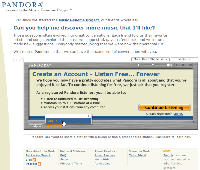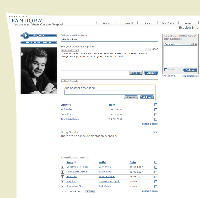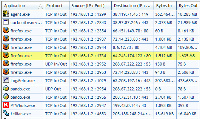|
|||||||||||||||||||||||||||||||||||||||||||||||||||||||||||||||||||||||||||||||||||||||||||||||||||||||||||||||||||
| Previous page | Do you use a pop-up blocker? If so, please read this. | ||||||||||||||||||||||||||||||||||||||||||||||||||||||||||||||||||||||||||||||||||||||||||||||||||||||||||||||||||
|
|||||||||||||||||||||||||||||||||||||||||||||||||||||||||||||||||||||||||||||||||||||||||||||||||||||||||||||||||||
| Show Date: 2007.06.17 | |||||||||||||||||||||||||||||||||||||||||||||||||||||||||||||||||||||||||||||||||||||||||||||||||||||||||||||||||||
Should you open Pandora's box?The disc jockey is dead. I'm old enough to remember when one of the reasons to listen to radio included the DJ. He (almost always a he in those days) was the one who tied the music together, wove in the commercials, talked long or short enough to make a clean network join, took requests, and probably kept an eye on the transmitter readings. With the Clear Channelization of radio, many DJs are just voice tracks recorded days before the program airs and often they're not even in the town where the radio station is. Independent stations such as CD101 (WWCD) and WCBE have local DJs, but they're a dying breed. Pandora is another nail in the coffin. Pandora is a streaming music service. You pick the music and Pandora plays it. You can pay $36 per year and omit advertisements or you can use the service for free and see the occasional ad. Pandora is a music discovery service that has a goal of helping listeners to enjoy music they're familiar with and to find musically related artists that you'll probably enjoy once you hear them. It's powered by the Music Genome Project, which the service describes as "a crazy project started back in early 2000 to capture the complex musical DNA of songs using a large team of highly-trained musicians." It's free and legal, but there are restrictions. You can't specify a particular song. There's no rewind or replay button. In this way, Pandora is like an all-music radio station. But if Pandora plays something you don't like, you can tell it you don't like what you're hearing and Pandora will move immediately to something else it thinks you will like. Pandora pays licensing fees to SoundExchange, ASCAP, BMI, and SESAC for all music that is played on Pandora. These payments ultimately go to the performing artists, songwriters, and record labels.
About the ads ...Er ... what ads? I've been using Pandora for several weeks and I've never seen an ad. I'm sure some will appear eventually, but for now the free service is fine. Overall: Music the way you want it when you want it.
My only complaint is that Pandora doesn't work on dial-up connections, but that's hardly Pandora's fault. If you want streaming music, you'll have a high-speed connection. Even with a high-speed connection (at least the one provided by Wide Open West) there's some stuttering. For more information, visit the Pandora website. Ruin this pictureOccasionally I hear from someone who has ruined a digital photo. The usual request is to identify a way to fix the image. Unfortunately, there isn't one. That's why there are two ironclad rules for working with digital images and a couple of suggestions for doing things in a way that you won't have to hope for a magic fix. How fast can you inadvertently ruin an image?
How to avoid these problemsIronclad rule #1: Never ever work on the original image. Before you do anything to an image save a copy of the file and work on that. When you do this, you'll always have an untouched original you can go back to if something goes wrong with the modifications. Ironclad rule #2: Save the copy in a lossless format, preferably the editing application's native file format. JPG files, the format most digital cameras use is a lossy format. Before you do anything at all to the image, some of the information the camera's sensor captured will have been lost. If you open, edit, and save a file several times, you will introduce additional information loss. Suggestion #1: Use an image editing application that allows you to make changes by applying those changes to adjustment layers instead of modifying the original image. This means that you'll have to spend some time learning how to use layers. It will be time well spent. Suggestion #2: When you're finished editing, if the application offers you the opportunity to "flatten" the file, don't do it. Flattening the layer eliminated all of the layers you've carefully added. If you keep the layers, you can always go back and modify one, add one, or delete one. Keep the layers. Nerdly NewsThe Vista update updateA couple of weeks ago, I did an in-place upgrade from Windows XP to Windows Vista. At the time, I said that I did an in-place upgrade in hopes that I wouldn't have to format the drive and reinstall all of the software. After two weeks, I've decided that I need to do what I assumed that I would eventually have to do: Format the drive and reinstall everything. It was a worthwhile experiment and I know that many people will successfully upgrade a computer from XP to Vista. I'm not surprised that this is the way things worked out because a lot of software comes to this machine, stays for a while, and then goes away. The upgrade, although successful, exhibits some problems that are symptomatic of upgrade problems. The problems were made far worse by Bitstream's Font Navigator that comes with Corel products. It is NOT compatible with Vista and ended up making a mess of the Windows fonts directory. As a result, some of the system fonts are missing and I haven't found an easy way to restore them. Possibly because of this, many of the components of Adobe's CS3 suite do not work properly. But, as I mentioned, this isn't entirely unexpected. I tried the in-place upgrade to see what would happen. I suspected all along that I would need to format the drive and start from there. So I have purchased bullets and will bite them this weekend. That means formatting the C drive and installing Windows Vista. It also means installing and updating lots of applications. By the time you read this (Saturday morning) the process should be well underway. And by the time you listen to the podcast (scheduled to be available Sunday morning) I should be well on the way to having all of the applications back in place. Thanks, AdobeWhen Adobe's CS2 suite arrived, I'd been running the beta version for a few months and the beta version left some junk in the Registry. Getting CS2 installed took a lot of effort on my part as well as by Adobe's support team. I was concerned that might be the problem this time around, too, because the applications are crashing and I can't run the "transfer license" procedure. Not to fear, says Adobe. Why? Because the company has changed its activation process to one that's more like the one used by Microsoft for its Office applications. The installation is machine-specific. That is, when the installer contacts Adobe to activate the license, it knows enough about the machine it's running on to realize that the suite has been reinstalled on a machine where it had been activated previously. So that process should go without a hitch. I hope. As an indication that Adobe must be doing something right, the company says it exceeded Q2 expectations. The results were driven by record performance of Creative Suite products and Adobe Acrobat. In addition to achieving record revenue, the software manufacturer posted GAAP operating income of $180.4 million and GAAP net income of $152.5 million, compared to $147.9 million and $123.1 million respectively in Q2 FY 2006. Do not put your keyboard in the dishwasherI suppose manufacturers will have to start putting that warning on keyboards. I would equate that warning with these:
Why do I feel a need at this point to suggest that you should not place your keyboard in the dishwasher? To answer that question, visit Google and perform a search with these words: keyboard dishwasher. Yes, someone actually tried it and others actually recommend it. I heard about this lunacy Thursday morning on NPR's Morning Edition. Yes, keyboards get dirty. Yes, they often have more germs than you'll find on many surfaces in bathrooms. But, no, the dishwasher is not a good place to put them for cleaning. Would you put your MP3 player in the dishwasher? How about a camera? A notebook computer? A portable television? There's a good chance that most people will say that they would not consider putting any of those items in a dishwasher. What's in an MP3 player, a camera, a notebook computer, and a portable television? Electronic components. What's in a keyboard? Electronic (and some mechanical) components. Electronic components and water don't mix well. I also recommend that you do not try to clean a keyboard by taking it into the bathtub or shower with you. Especially if it's still plugged in to the computer and the computer is turned on. |
|||||||||||||||||||||||||||||||||||||||||||||||||||||||||||||||||||||||||||||||||||||||||||||||||||||||||||||||||||
|
|||||||||||||||||||||||||||||||||||||||||||||||||||||||||||||||||||||||||||||||||||||||||||||||||||||||||||||||||||
| Home • Programs • Reference • Subscribe to Technology Corner News • Contact Us • Terms of Use ©2007 by William Blinn Communications. All rights reserved. |
|||||||||||||||||||||||||||||||||||||||||||||||||||||||||||||||||||||||||||||||||||||||||||||||||||||||||||||||||||
This is the only ad you'll ever see on this site. It's for my website host, BlueHost in Orem, Utah. Over the past several years, they have proven to be honest, reliable, and progressive. If you need to host a website, please click the banner below to see what BlueHost has to offer. |
|||||||||||||||||||||||||||||||||||||||||||||||||||||||||||||||||||||||||||||||||||||||||||||||||||||||||||||||||||

|
|||||||||||||||||||||||||||||||||||||||||||||||||||||||||||||||||||||||||||||||||||||||||||||||||||||||||||||||||||






























